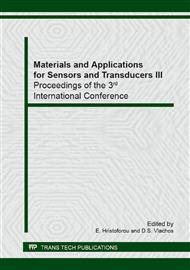[1]
DS Vlachos, DK Fragoulis, JN Avaritsiotis An adaptive neural network topology for degradation compensation of thin film tin oxide gas sensors, Sensors and Actuators B: Chemical, 45, 3, p.223–228, (1997)
DOI: 10.1016/s0925-4005(97)00309-2
Google Scholar
[2]
CA Papadopoulos, DS Vlachos, Effect of surface catalysts on the long-term performance of reactively sputtered tin and indium oxide gas sensors, Sensors and Actuators B: Chemical 42, 2, p.95–101, (1997)
DOI: 10.1016/s0925-4005(97)00190-1
Google Scholar
[3]
I. Giouroudi, A. Ktena and E. Hristoforou, Microstructural characterization of cylindrical Fe1-xNix thin films, J. Opt. Adv. Mat., 6, pp.45-50, (2004)
Google Scholar
[4]
E. Hristoforou, "Magnetostrictive Delay Lines: Engineering Theory and Sensing Applications", Meas. Sci. & Technol., 14, p. R15-R47, (2003)
DOI: 10.1088/0957-0233/14/2/201
Google Scholar
[5]
E. Hristoforou, Magnetic Effects in Physical Sensor Design, J. Opt. Adv. Mat., 4, pp.245-260, (2002)
Google Scholar
[6]
E. Hristoforou and D. Niarchos, Mechanical Sensors Based on Re-Entrant Flux Reversal, IEEE Trans. Mag., 28, pp.2190-2192, (1992)
DOI: 10.1109/20.179439
Google Scholar
[7]
C. Petridis, I Petrou, PD Dimitropoulos, E Hristoforou, Determining appropriate magnetic core properties for a new type of flux-gate like sensor, Sensor Letters, 5, pp.98-101, (2007)
DOI: 10.1166/sl.2007.072
Google Scholar
[8]
I. Petrou, P. Skafidas, E. Hristoforou, Electronic toll and road traffic monitoring system using 3-D field AMR sensors, Sensor Letters, 11, pp.91-95, (2013)
DOI: 10.1166/sl.2013.2787
Google Scholar
[9]
E. Hristoforou, New monolithic three dimensional field sensors with high sensitivity, J. Opt. Adv. Mat., 8, pp.1691-1697, (2006)
Google Scholar
[10]
C. Petridis, A. Ktena, E. Laskaris, PD Dimitropoulos, E Hristoforou, Ni-Fe thin film coated Cu wires for field sensing applications, Sensor Letters, 5, pp.93-97, (2007)
DOI: 10.1166/sl.2007.071
Google Scholar
[11]
C. Petridis, P. D. Dimitropoulos, E. Hristoforou, New Magnetic Field Sensor Based on Combined Flux-Gate/Hall-Effect Arrangement, IEEE Sensors Journal, 9, pp.128-134, (2009)
DOI: 10.1109/jsen.2008.2011083
Google Scholar
[12]
E. Hristoforou, H. Hauser and PD Dimitropoulos, On a New Principle of Smart Multi-Sensor Based on Magnetic Effects, IEEE Sensors, 6, pp.372-379, (2006)
DOI: 10.1109/jsen.2005.859781
Google Scholar
[13]
Holmes, J. J., Reduction of a ship's magnetic field signatures Synthesis Lectures on Computational Electromagnetics, 3(1), pages 68, (2008)
Google Scholar
[14]
Information on http://www.emcos.com/Naval-EMC-Simulations
Google Scholar
[15]
E. Hristoforou, New Position Sensor Based on the Magnetostrictive Delay Line Principle, Sensor Letters, 7, pp.303-309, (2009)
DOI: 10.1166/sl.2009.1071
Google Scholar
[16]
Petrou, J., Skafidas, P., & Hristoforou, E. (2013). Electronic toll and road traffic monitoring system using 3-D field AMR sensors, Sensor Letters, 11(1), p.91 – 95
DOI: 10.1166/sl.2013.2787
Google Scholar
[17]
Haykin, S. Neural networks: A Comprehensive Foundation, 2nd ed, Prentice-Hall, 1999.
Google Scholar
[18]
Messai, N., Thomas, P., Lefebvre, D., & Moudni, A. E. Neural networks for local monitoring of traffic magnetic sensors. Control Engineering Practice, 2005, 13(1), pp.67-80.
DOI: 10.1016/j.conengprac.2004.02.005
Google Scholar
[19]
Fateh, B., Modeling, simulation and optimization of a microcoil for MRI. Computational Engineering, University of Rostock, Germany, (2006)
Google Scholar
[20]
Demuth, H. Neural network toolbox for use with MATLAB R2013a: User's guide, MathWorks, (2013)
Google Scholar


